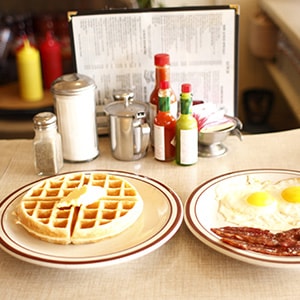With the right advice and concept, familiarize yourself with what the final product should look like.A restaurant business plan is the foundation when starting a new restaurant, whether you're opening a franchise or a small family-owned restaurant. Your business plan will act as a roadmap for starting your restaurant: it can help you get loans from financial institutions, and it will be a point of reference when forecasting sales. In this article, we'll teach you all of the essential information to include in your restaurant business plan as well as walk you through the process of writing a restaurant business plan. Many people dream of opening a restaurant and see it as an opportunity to turn a love for entertaining or cooking into a business. Unfortunately, for many restaurateurs, the reality of running a restaurant is not what they expected. Long hours, low pay, and a lot of stress cause many entrepreneurs to close shop after just a few years.

What Should You Include in a Restaurant Business Plan?
Your business plan will be a guide through the process of starting a new business, but you may also share it with potential investors, so there's a number of useful things that you'll want to include in it. Here are some key ideas to include in your restaurant business plan:
Concept: Your restaurant's concept is the theme that ties all of the elements, such as your menu and decor, together. Having a strong concept is essential for opening a successful restaurant.
Sample Menu: Early in the process of starting a restaurant, you should think about what type of food you want to make and sell. Your sample menu doesn't need to be extensive, but give readers a few examples of the types of food you're planning on serving.
Management Structure: Investors will want to know how your restaurant is structured. Are you going to be the sole owner or is it a partnership? Are you starting an LLC or taking sole proprietorship?
Market Analysis: Is your new restaurant going to be located in a competitive market? What are the demographics in that region? Is your business going to be able to succeed in the current market? These are all issues that you should cover in your restaurant's business plan.
Financials: The centerpiece of every business plan are the financials. Be sure to have answers to how much money you're planning on spending, how long it'll take to become profitable, and where you're planning on getting financing.
One reason for the high failure rate in this industry is that restaurant owners fail to treat their restaurant operation as a business from the very beginning. They have no plan to deal with problems and unexpected expenses and don't understand the scope of the cost associated with opening a restaurant. One way to prevent these types of problems is to develop a well-written business plan. By writing a restaurant business plan, you accomplish two things:
Showing the bank you have a clear plan for getting your restaurant up and running.
Developing a contingency plan to handle problems.
These are some of the topics that you should cover throughout your restaurant business plan. This information will be spread out through the various sections of the document, but having concrete answers to these questions and topics will help your business prepare for the challenges of opening.
In structure, a restaurant business plan needs to be like most business plans, but the details need to address the specifics of your vision for a restaurant and how it fills a void in your local market.
Using the same general components of a standard business plan, see how you can gear it specifically to the restaurant industry and how you fit into that industry:
Sections in a Restaurant Business Plan
Business plans are typically split it up into multiple sections to keep them organized. There are eight essential sections in restaurant business plans, which are listed below. You can click on the section to learn more about it.
Executive Summary
Company Description
Concept and Menu
Management and Ownership Structure
Employees and Staffing Needs
Market and Competitor Analysis
Advertising and Marketing Strategies
Financials
1. Executive Summary.
This overview needs to introduce your entire business plan with a couple of key broad strokes: What niche will you fill in the local dining market, and what role will you play? Make it clear to the reader (a potential investor) what kind of restaurant you will be. From fast casual to sports bars to fine dining to ethnic cuisine and many more options, there are all kinds of restaurants. Let the investor know how you'll fit into the market, including the name of your restaurant and its location.
Also make it clear to the reader what your role will be. Restaurants are multilayered businesses, and one person trying to build a menu, cook the food, and run the business operation will be overwhelmed. If you're an experienced chef with a plan for a fine dining restaurant, then make it clear to readers that your primary role will be in the kitchen and that you're hiring experienced professionals to handle other key roles.
2. Company Description
The company description section, also called a company overview, contains all of the same information as the executive summary, but provides greater detail on each part of your business plan. For example, your company description should include more detailed financial projections and any marketing strategies you've designed.
In a restaurant business plan, the executive summary will get readers interested, and then your company overview has more in-depth information that you can give them to give a complete overview of your new restaurant. Additionally, the company overview of your business plan is your chance to explain, in more specific terms, how and why you're opening a restaurant.
When writing a company description, be sure to answer these questions:
What is your restaurant's concept?
What makes your restaurant unique?
What sort of items will be on your menu?
Who is your target audience, and what are their spending and eating habits?
What team members do you have lined up?
How is your restaurant going to function in a day-to-day capacity?
What sort of management structure are you planning to use?
Do you have any logos or marketing materials prepared?

3.Concept and Menu
A restaurant concept is the overall idea or theme that defines the restaurant. Concepts include the your menu's design, service style, dining room decor, and — of course — the style of food. Many restaurants are conceived based on a chef’s personal experiences or interests. Heritage, local ingredients, traditions, or family are all common sources of inspiration for restaurant concepts. But concepts can also be defined by a chef’s travel experience, training, or an interest in a certain area of art, science, or culture. Because food is, after all, a mixture of all those things. Read on to explore the elements of a concept, some steps to help guide your choices, and even some restaurant concept examples.
While you may cover your restaurant's concept and menu ideas in other sections of your restaurant business plan, this section allows you get into the finer details. You can divide this section up into three main parts: menu, service, and decor. We'll break down each section below.
Menu Ideas and Design
You can include your sample menu design in this section. If you don't have a full mockup of your restaurant's menu, then list some of the items or recipes that you're planning on using.
Restaurant Service
Are you planning on opening a fine dining restaurant or a fast casual establishment? Will you have a full-time wait staff or just a service counter where customers can order and pick up their food? For many restaurants offering standard service, this section will be fairly short.
Design and Decor
This is the section of your business plan where you can show any branded materials or logos that have already been designed for your new restaurant. Additionally, you can include any design and decor choices you've made, such as your color scheme, furniture choices, or tableware aesthetic.
4. Management and Ownership.
Who is going to helm the ship? Again, following the example of the owner focusing on duties as the executive chef, who else will be part of the management team? How will the hierarchy be structured? For example, will there be a single general manager who reports to you with other managers—dining room, bar, business, etc.—reporting to her? Or, will everyone report to you equally? The structure you choose is less important than actually choosing a structure that works for you and making it clear to investors that you do have a plan and understand how it will function effectively.

5. Staffing and Employment

Once you've laid out your restaurant's ownership and management structures, you can get into the finer details of your staffing needs. In this section, you can lay out exactly what your staffing needs are, such as how many servers you'll need, kitchen staff requirements, as well as any employees, such as managers or chefs, that you already have on staff.
Additionally, it will be worth noting in this section if you, the owner, will be working in the restaurant in a management or chef role. You can also list any employee handbooks or wait staff training materials you have prepared.
Be sure to also list any auxiliary employees that are affiliated with your restaurant, such as accountants, lawyers, advertising agencies, or contractors.
6. Market Analysis
Requiring some of the most research, the market analysis section of your restaurant business plan will explain to potential investors how your new business will fit into the existing market. This section can also be broken down further into two main types of analysis: demographic analysis and competitive analysis.
Demographic Analysis
Understanding your target demographic is essential for success when opening a new restaurant. You can detail information about your target demographic in this section of your restaurant business plan. Here is some important information to include:
- What's the age of your target demographic?
- What is their income level?
- How much disposable income do they have?
- How much money do they typically spend on eating out?
This information will help you understand your potential customers, what they're interested in, their eating and spending habits, so you can adapt to cater to their wants and needs. When writing this section of your restaurant business plan, you want to make sure that you're in-depth, and you can also use the data to draw conclusions to persuade potential investors.
Competitive Analysis
The other half of market analysis is analyzing the competition in your restaurant's chosen location. Established restaurants will have a loyal customer base, so you need to make sure that your business is targeting a different demographic or has a competitive edge that can entice customers away from your competitors.
Here are some things to think about when compiling competitive analysis:
- How many restaurants are in your target area?
- Do any of these competitors offer similar menus or services to your new restaurant?
- How do their menu prices compare to your menu?
- Are there any non-traditional competitors in the area, such as grocery stores and convenience stores offering ready-to-go meals?
When you spread out this data in your restaurant strategy, you can start to portray your arrangement for contending with these organizations and increasing a dedicated after.
Likewise think about how close different eateries must be to your own to be viewed as rivalry. In case you're in a city the circle of rivalry may just be a couple of square squares, however it could be a few miles in country or rural areas.
Likewise think about how close different eateries must be to your own to be viewed as rivalry. In case you're in a city the circle of rivalry may just be a couple of square squares, however it could be a few miles in country or rural areas.
7. Marketing and Advertising Strategies
After you've identified your target demographics and competitors in the previous section, you can begin outlining your plan to appeal to those customers and to compete with other businesses in your area in the marketing and advertising strategies section.
There are a number of marketing and advertising tactics that your business can take to get your new restaurant's name out there. Some of the most popular options include hosting opening day events, starting a social media marketing campaign, offering coupons to potential customers, or creating customer loyalty programs.
In this section, you'll want to list all of the marketing and advertising strategies you're planning on implementing, how they'll benefit your business, what exactly is involved in each tactic, and how you're planning to enact them. For example, you can detail how you're going to hire a marketing agency to create a run a social media account for your restaurant to create excitement before it opens.
8. Financial Data
One of the most important sections in your restaurant business plan, the financial data will also require the most significant amount of research and work on your part. To find this financial data you can use experience from previous restaurants you've worked at or operated, use estimates from suppliers, and research available financial information in your specific region.

You should organize the information in your financial section based on the people you're presenting your business plan to. For example, if you're preparing a presentation for the bank to receive a loan, you will want to put information about how long it will take your business to become profitable and a break-even analysis at the beginning of this section.
Regardless of how you organize the data in the financials section of your restaurant business plan, here is some information that you want to make sure you include:
- How much capital you have on hand currently.
- A breakdown of your expected startup costs, such as new kitchen equipment, lease payments, renovations, or licensing fees.
- A timeline of how long you expect it will take for your restaurant to become profitable.
- How much money you expect your business will spend on a daily and weekly basis.
- Sales forecasting based on previous experience or competitor data.
- A list of recurring expenses, such as overhead, labor, and food costs.
When writing your restaurant business plan, make certain to consider the individual that will understand it and the data they're most intrigued by. However, additionally remember that your marketable strategy will be a reference for you to pursue all through the way toward opening your new café, and fill it will data that isn't just useful to potential financial specialists, yet in addition you and your supervisory crew.
.
Thanks for sharing such a nice blog. keep on sharing. if anyone intrested on
ReplyDeletetakeaway software,
central kitchen software,
best restaurant billing software,
restaurant pos system,
restaurant pos software,
contactless ordering,
cloud kitchen setup